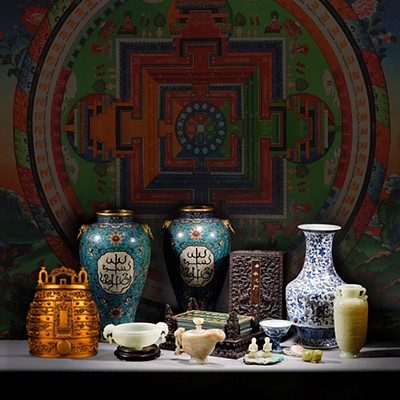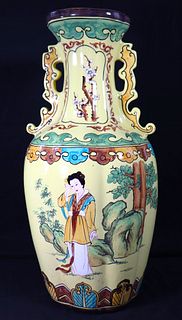A very rare Xuande porcelain Ding
About Seller
5091 Walnut Grove Ave
San Gabriel, CA 91776
United States
For over 30 years, Jumbo Auction House has been dedicated to curating collections of unique works of art for art lovers, decorators, novice collectors and fellow experts alike.
About Auction
Aug 10, 2022 - Aug 31, 2022
Jumbo Auction House is proud to bring you items of enticing Chinese works of art from private collection legacy, including important jade, bronze, cinnabar lacquer, paintings, jewelry, soapstone, snuff bottles, statues, porcelain vases, carvings, coins and much more! Jumbo Auction House jumboauction@yahoo.com
- Lot Description
Ding is an important Chinese utensil. Bronze dings started in Shan more than 3500 years ago and was used for ceremonial and cooking purposes. Soon it became the most important utensil and a symbol of imperial power, (???????). This ding has a fine, hard, and thick body made of Ma Chan Hill clay. The clay was used to make imperial wares during early Ming (including Xuande ); sometimes during firing it yields “kiln red” that has a color ranging from brownish yellow to orange red. Xuande (1426-1435 AD porcelain wares are known to be heavily built; this is a good example. The stout four feet are disproportional strong for porcelain wares of this size, perhaps intending to make an impression of power and stability. The walls and the ridges around the mouth rim are not straight, warp somewhat, demonstrating the difficulty of making/firing flat porcelain surface at high temperature during Xuande. The intense blue colored glaze is also unique for Xuande period. Its surface has lost almost all the shine of newly fired porcelain, which is called thief gloss. Under 25x magnification glass, the lack of uniformity of blue is seen, with white and blackish blue dots intermingling. On ridgelines the blue glaze drains thin and showing white clay below. This phenomenon is common among ancient monochrome glazes, and is called Chu Jin. These are a characteristic of Yuan and early Ming blue glaze. On one side the motif is a trigram (Ba Gua) that was derived from Yuan motifs. But the motif on the other side, cross-sabers, is extremely rare in ancient Chinese porcelain; perhaps it was due to Arabian influence that existed during Yuan and early Ming. Although this Ding is not marked, all the features indicate that it was made during Xuande for palace use. (During early Ming many imperial wares were not marked.) . From Dr. Robert I-San Lin (#1541), a senior Chinese artwork appraiser, whose grandfather was a major Chinese antique merchant in early 1900s. (Dr. Lin’s bio, in Journal of Authentication of Artworks, 2015, available). Brought to California in 1960s. 19.9 (H) x 14 x 9.2 cm; 1304 grams.NOTE: Any condition statement is given as a courtesy to a client, is only an opinion and should not be treated as a statement of fact. Jumbo Auction House shall have no responsibility for any error or omission. The absence of a condition statement does not imply that the lot is in perfect condition or completely free from wear and tear, imperfections, or the effects of aging. We do not carry out in-depth research of the sort carried out by professional historians and scholars, and any statements made by us orally or in writing about any lot concerning attribution to an artist, provenance, period, materials, origin, history, or dates represent an opinion of Jumbo Auction House and are not to be relied on as a statement of fact. Such opinions serve for informative purposes only and do not constitute historic or academic scholarship on the works and do not aim to substitute or contradict any such scholarship.
Condition
- Shipping Info
-
No property will be released until payment in full has cleared. Any expense related to packing, shipping and insurance (including reimbursement for damage or loss) of purchased lots is the responsibility of the buyer. Jumbo Auction House does not offer in-house shipping service for MOST items. Please arrange your own shipper to pick up the item(s) or we are happy to recommend shippers to you upon request. The emails of the two local shippers we recommend are on the invoice. Paid-for merchandise must be collected by the buyer or an authorized representative no later than forty-five (45) days following the date of the auction. Any merchandise remaining after this period will be subject to a storage fee of $10 per lot/per day. Please Note: Responsibility and all liability of items as well as safe delivery are assumed by carrier, shipper, buyer, agent or packing company upon acceptance of merchandise. Buyer will not hold Jumbo Auction House liable for any damage or loss after merchandise has been released from our possession.
-
- Payment & Auction Policies
-
Available payment options
-
-



 EUR
EUR CAD
CAD AUD
AUD GBP
GBP MXN
MXN HKD
HKD CNY
CNY MYR
MYR SEK
SEK SGD
SGD CHF
CHF THB
THB

























